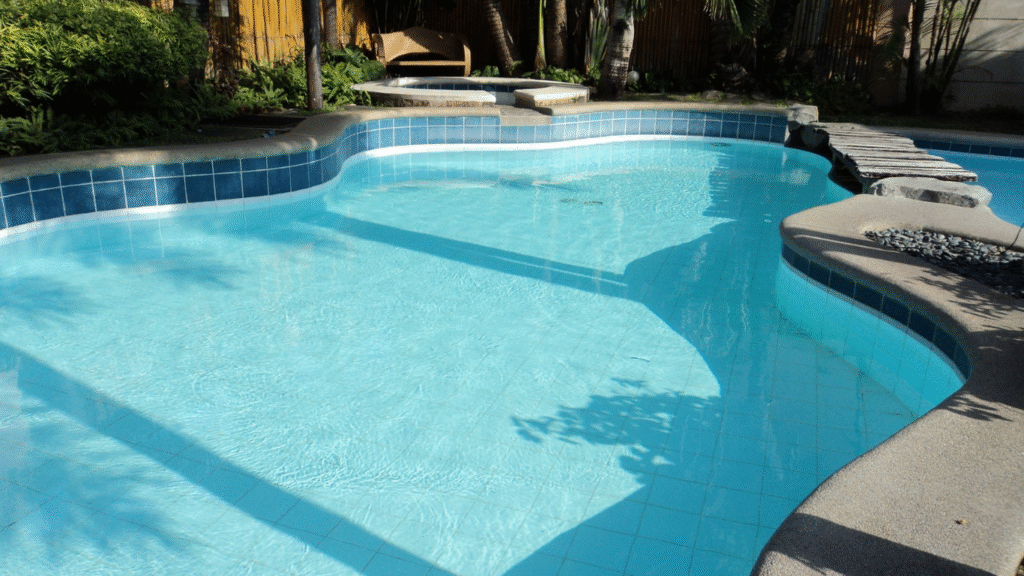Hey there, if you’re thinking about adding a pool to your backyard, you’ve probably heard about gunite and fiberglass options. It’s a big decision, right? Pools aren’t cheap, and you want something that fits your life and lasts. Gunite pools are basically concrete pools sprayed into shape, super tough and custom-built. Fiberglass ones come pre-made like a big shell you drop in. Both have their ups and downs, and I’ll break it all down here so you can figure out what’s best. We’ll look at how they’re made, costs, upkeep, and more. By the end, you’ll have a clearer picture. Let’s jump in.
What is a Gunite Pool?
A gunite pool is like building a pool from scratch with concrete. They mix dry concrete with water and shoot it out of a hose onto a frame made of steel bars. Once it’s sprayed on, workers shape it by hand to get the look you want. Then they add a plaster finish or tiles for the smooth surface. This method started back in the early 1900s, and it’s still popular because you can make any shape or size. Want a curvy pool with waterfalls or benches? Gunite lets you do that.
One big plus is how strong they are. Gunite pools can handle tough weather, like freezes or hot sun, without cracking easy. They last a long time, often 50 years or more if you take care of them. But they’re not perfect. Building one takes time—usually 3 to 6 months from start to swim. You dig the hole, put in plumbing, add the rebar, spray the gunite, let it cure for weeks, then finish it up. That means your yard’s a mess for a while.
Costs? Expect to pay more upfront. A basic gunite pool might start at $70,000, but with extras like heaters or lights, it can hit $100,000 or higher. And maintenance is key. The surface is a bit rough, so algae can stick easier, meaning more brushing and chemicals. Every 10-15 years, you might need to replaster, which costs a few thousand bucks. Still, if you love customizing and plan to stay in your house forever, gunite feels solid and like it’s part of your home. It’s like investing in something built to last, not just slapped together.
What is a Fiberglass Pool?
Fiberglass pools are different—they’re like buying a ready-made tub for your yard. Factories mold them from fiberglass material, which is strong plastic reinforced with glass fibers. They coat it with a gel that makes it shiny and smooth. When you’re ready, a truck brings the whole shell to your house, they dig a hole, drop it in, hook up the pipes, and fill it with water. It’s quick, often done in just a few weeks or even days if everything goes smooth.
The big draw here is how easy they are. No waiting months for concrete to dry. You pick from shapes and sizes the company offers, like rectangles or kidneys, but you can’t go totally custom like with gunite. They’re great for smaller yards or if you want to swim sooner. Durability-wise, fiberglass holds up well, lasting 25 to 50 years. The smooth surface fights off algae, so you use less chlorine and spend less time cleaning. Plus, they’re flexible, so they handle ground shifts better without cracking.
But watch out for a few things. If the ground water is high, the pool might pop up if you drain it—though pros can prevent that with good install. Over time, the color might fade from sun and chemicals, or blisters could form, but that’s rare with good brands. Installation costs less, around $50,000 to $80,000, making it cheaper to start. Maintenance is a breeze—you brush less, and repairs are simple, like patching a boat. If you’re busy or hate yard work, fiberglass feels like a smart, low-hassle choice. It’s not as fancy as gunite, but it gets the job done without the fuss.
Cost and Installation Comparison
Money and time are huge factors when picking a pool. Let’s talk costs first. Fiberglass pools usually win on price. You might spend $50,000 to $85,000 for a full setup, including digging and extras like decks. Gunite? It’s pricier, often $70,000 to $120,000 or more, because of all the custom work and materials. But think long-term—gunite might add more value to your house since it’s seen as premium and lasts longer. Fiberglass is quicker to pay off if you’re flipping the house soon.
Installation is where fiberglass shines. Dig the hole, crane in the shell, connect everything, and you’re swimming in 1-3 weeks. No big delays from weather, since most work is off-site. Gunite takes longer—excavate, build the frame, spray the mix, cure it (which needs dry days), then finish. That can stretch to 2-4 months, and rain can mess it up. Your yard’s torn up longer, which sucks if you have kids or pets.
Hidden costs matter too. For gunite, add in future replastering every decade, maybe $10,000 each time. Fiberglass needs less, but if it cracks (rare), fixing might cost $5,000. Energy bills? Both similar, but fiberglass heats up faster because it’s insulated better. Location plays a role—if your soil is rocky, gunite handles it easier without extra prep. Overall, if budget’s tight and you want fast, go fiberglass. If you can spend more for custom, gunite’s worth the wait.
Maintenance and Durability Face-Off
Keeping your pool nice is key to enjoying it. Fiberglass is easier here. Its smooth, non-porous shell means algae doesn’t stick much, so you scrub less and use fewer chemicals—saving money and time. Weekly brushing and checking pH is usually enough. In winter, they’re simple to close up. Durability? They resist fading and cracking, but extreme temps or poor install can cause issues like bulging. With care, they last 30-50 years.
Gunite pools need more love. The plaster surface is porous, so dirt and algae build up faster. You’ll brush weekly, shock the water often, and balance chemicals carefully. Every few years, acid wash to clean stains. But they’re tough—concrete withstands heavy use, kids jumping, even earthquakes better. They can last 50-100 years, but replastering is a must every 10-15 years to avoid rough spots or leaks. Repairs are straightforward, like patching cracks.
Weather-wise, gunite handles freezes well with proper draining, while fiberglass might need heaters in cold spots. Both can get damaged by bad water chemistry, but fiberglass forgives mistakes more. If you’re hands-on and want something bombproof, gunite’s great. For low-effort, fiberglass wins. Either way, regular checks keep problems small.
Which One Should You Choose?
Deciding between gunite and fiberglass comes down to your needs. If you dream of a unique pool that matches your yard perfectly—like with infinity edges or built-in spas—gunite is your pick. It’s customizable, super durable, and feels luxurious. Great for big families or if you’re staying put long-term. But be ready for higher costs, longer build time, and more upkeep.
Fiberglass suits folks who want simple and fast. Perfect for smaller spaces, quick summers, or if you’re not into heavy maintenance. It’s cheaper to start, easier to clean, and still looks good. Downsides? Limited designs and maybe less wow factor. If resale matters, check local trends—some areas love custom gunite for value.
Think about your yard too. Slopes or trees? Gunite adapts better. High water table? Both work, but install pros handle it. Budget for ongoing costs—fiberglass saves on chemicals, gunite on longevity. Talk to local builders for quotes; prices vary by area. In the end, both make awesome backyards. Pick what fits your life—relaxing dips or epic parties—and you’ll love it.
FAQs
What’s the main difference between gunite and fiberglass pools?
Gunite pools are built on-site with sprayed concrete for custom shapes, while fiberglass are pre-made shells dropped into a hole for quicker setup.
Which pool type lasts longer?
Gunite pools often last 50+ years with proper care, compared to 25-50 years for fiberglass.
Are fiberglass pools cheaper than gunite?
Yes, fiberglass usually costs less upfront, but gunite might offer better long-term value.
Which is easier to maintain?
Fiberglass, thanks to its smooth surface that resists algae.
Can I customize a fiberglass pool?
Not as much as gunite; you’re limited to factory shapes.



